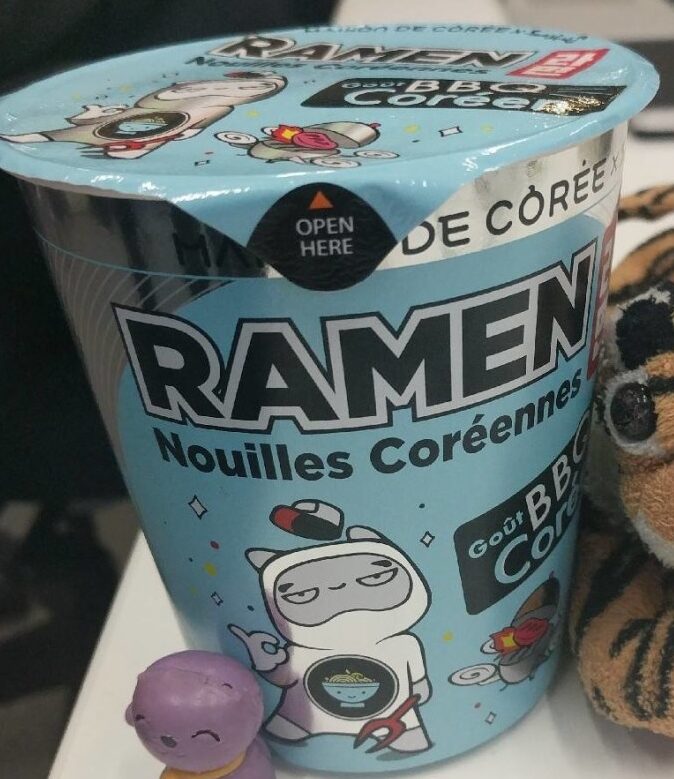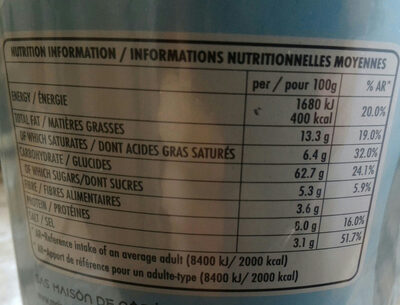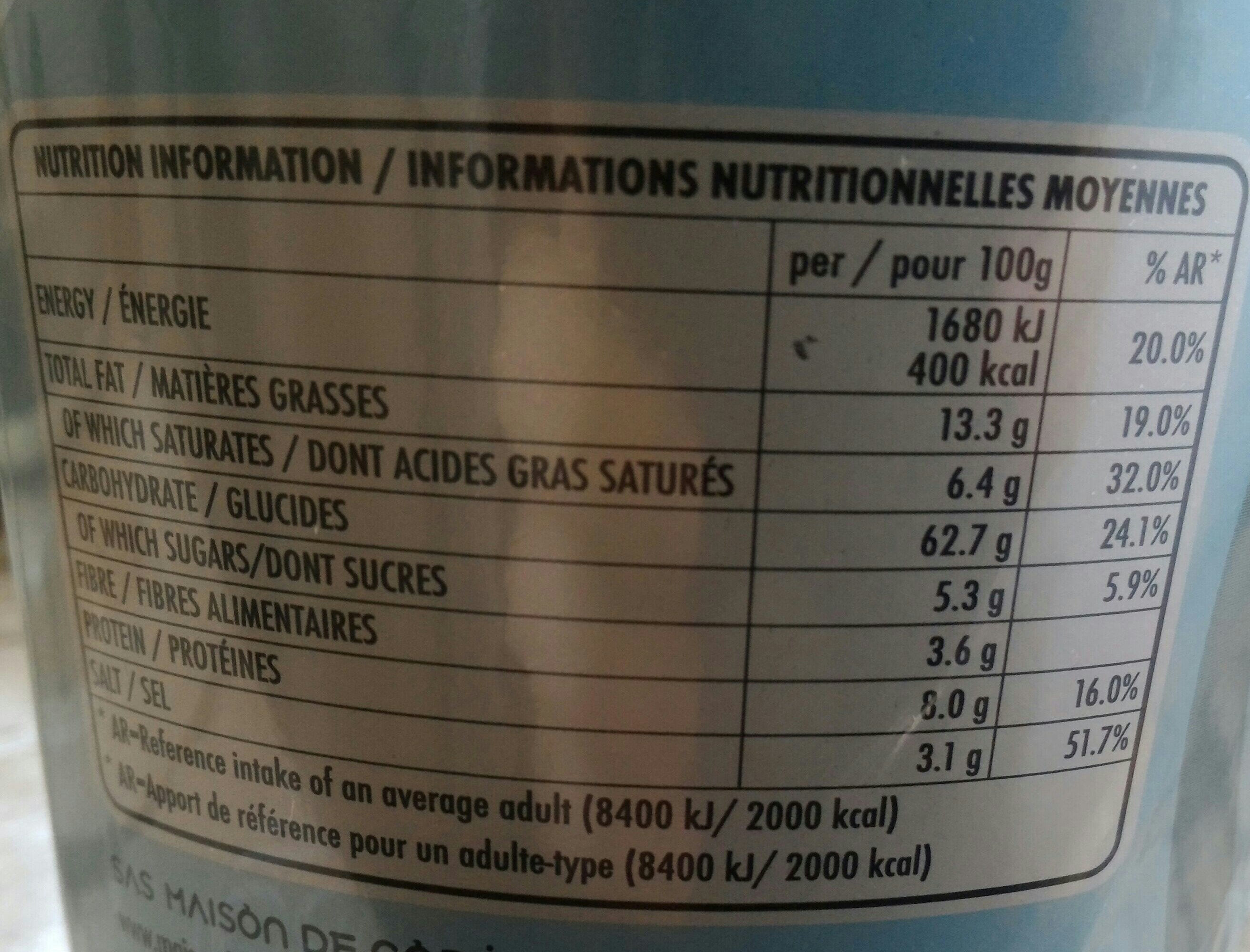Help us make food transparency the norm!
As a non-profit organization, we depend on your donations to continue informing consumers around the world about what they eat.
The food revolution starts with you!
Ramen nouilles coréennes goût BBQ coréen - Maison de Corée - 75 g
Ramen nouilles coréennes goût BBQ coréen - Maison de Corée - 75 g
This product page is not complete. You can help to complete it by editing it and adding more data from the photos we have, or by taking more photos using the app for Android or iPhone/iPad. Thank you!
×
Barcode: 8805957019479 (EAN / EAN-13)
Quantity: 75 g
Packaging: Plastic, fr:Individuel
Brands: Maison de Corée, Samyang
Categories: Plant-based foods and beverages, Plant-based foods, Cereals and potatoes, Cereals and their products, Dried products, Pastas, Dried products to be rehydrated, Noodles, Instant noodles, Chinese noodles
Stores: Monoprix
Countries where sold: France
Matching with your preferences
Health
Ingredients
-
45 ingredients
: Nouilles (70.3%) : Farine de blé, amidon de tapioca modifié, huile de palme raffinée, gluten de blé, sel, émulsifiant (E322), régulateur d'acidité (E501, E500, E339, E330), extrait d'oignon, épaississant (E412), huile d'arôme de thé vert. Sachet de sauce (26.7%) : eau, extrait de levure, sucre, sauce de soja, exhausteur de goût (E621), huile de soja, sirop de maïs, colorant (150C), ail, oignon, vinaigre, extrait de bonite, amidon de pomme de terre modifié, poudre de piment noir, exhausteur de goût (E627), thon fumé, huile d'arôme de boeuf artificiel, édulcorant (E960), poudre de lactobacillus fermenté. Légumes (3%) : chou séché, chou bok choy séché, carotte séchée.Allergens: Gluten
Food processing
-
Ultra processed foods
Elements that indicate the product is in the 4 - Ultra processed food and drink products group:
- Additive: E322 - Lecithins
- Additive: E412 - Guar gum
- Additive: E621 - Monosodium glutamate
- Additive: E627 - Disodium guanylate
- Additive: E960 - Steviol glycosides
- Ingredient: Colour
- Ingredient: Emulsifier
- Ingredient: Flavour enhancer
- Ingredient: Gluten
- Ingredient: Sweetener
- Ingredient: Thickener
Food products are classified into 4 groups according to their degree of processing:
- Unprocessed or minimally processed foods
- Processed culinary ingredients
- Processed foods
- Ultra processed foods
The determination of the group is based on the category of the product and on the ingredients it contains.
Additives
-
E322 - Lecithins
Lecithins are natural compounds commonly used in the food industry as emulsifiers and stabilizers.
Extracted from sources like soybeans and eggs, lecithins consist of phospholipids that enhance the mixing of oil and water, ensuring smooth textures in various products like chocolates, dressings, and baked goods.
They do not present any known health risks.
-
E330 - Citric acid
Citric acid is a natural organic acid found in citrus fruits such as lemons, oranges, and limes.
It is widely used in the food industry as a flavor enhancer, acidulant, and preservative due to its tart and refreshing taste.
Citric acid is safe for consumption when used in moderation and is considered a generally recognized as safe (GRAS) food additive by regulatory agencies worldwide.
-
E339 - Sodium phosphates
Sodium phosphates: Sodium phosphate is a generic term for a variety of salts of sodium -Na+- and phosphate -PO43−-. Phosphate also forms families or condensed anions including di-, tri-, tetra-, and polyphosphates. Most of these salts are known in both anhydrous -water-free- and hydrated forms. The hydrates are more common than the anhydrous forms.Source: Wikipedia
-
E412 - Guar gum
Guar gum (E412) is a natural food additive derived from guar beans.
This white, odorless powder is valued for its remarkable thickening and stabilizing properties, making it a common ingredient in various food products, including sauces, dressings, and ice creams.
When used in moderation, guar gum is considered safe for consumption, with no known adverse health effects.
-
E500 - Sodium carbonates
Sodium carbonates (E500) are compounds commonly used in food preparation as leavening agents, helping baked goods rise by releasing carbon dioxide when they interact with acids.
Often found in baking soda, they regulate the pH of food, preventing it from becoming too acidic or too alkaline. In the culinary world, sodium carbonates can also enhance the texture and structure of foods, such as noodles, by modifying the gluten network.
Generally recognized as safe, sodium carbonates are non-toxic when consumed in typical amounts found in food.
-
E501 - Potassium carbonates
Potassium carbonate: Potassium carbonate -K2CO3- is a white salt, which is soluble in water -insoluble in ethanol- and forms a strongly alkaline solution. It can be made as the product of potassium hydroxide's absorbent reaction with carbon dioxide. It is deliquescent, often appearing a damp or wet solid. Potassium carbonate is used in the production of soap and glass.Source: Wikipedia
-
E621 - Monosodium glutamate
Monosodium glutamate: Monosodium glutamate -MSG, also known as sodium glutamate- is the sodium salt of glutamic acid, one of the most abundant naturally occurring non-essential amino acids. Glutamic acid is found naturally in tomatoes, grapes, cheese, mushrooms and other foods.MSG is used in the food industry as a flavor enhancer with an umami taste that intensifies the meaty, savory flavor of food, as naturally occurring glutamate does in foods such as stews and meat soups. It was first prepared in 1908 by Japanese biochemist Kikunae Ikeda, who was trying to isolate and duplicate the savory taste of kombu, an edible seaweed used as a base for many Japanese soups. MSG as a flavor enhancer balances, blends, and rounds the perception of other tastes.The U.S. Food and Drug Administration has given MSG its generally recognized as safe -GRAS- designation. A popular belief is that large doses of MSG can cause headaches and other feelings of discomfort, known as "Chinese restaurant syndrome," but double-blind tests fail to find evidence of such a reaction. The European Union classifies it as a food additive permitted in certain foods and subject to quantitative limits. MSG has the HS code 29224220 and the E number E621.Source: Wikipedia
-
E627 - Disodium guanylate
Disodium guanylate: Disodium guanylate, also known as sodium 5'-guanylate and disodium 5'-guanylate, is a natural sodium salt of the flavor enhancing nucleotide guanosine monophosphate -GMP-. Disodium guanylate is a food additive with the E number E627. It is commonly used in conjunction with glutamic acid. As it is a fairly expensive additive, it is not used independently of glutamic acid; if disodium guanylate is present in a list of ingredients but MSG does not appear to be, it is likely that glutamic acid is provided as part of another ingredient such as a processed soy protein complex. It is often added to foods in conjunction with disodium inosinate; the combination is known as disodium 5'-ribonucleotides. Disodium guanylate is produced from dried seaweed and is often added to instant noodles, potato chips and other snacks, savory rice, tinned vegetables, cured meats, and packaged soup.Source: Wikipedia
-
E960 - Steviol glycosides
Steviol glycoside: Steviol glycosides are the chemical compounds responsible for the sweet taste of the leaves of the South American plant Stevia rebaudiana -Asteraceae- and the main ingredients -or precursors- of many sweeteners marketed under the generic name stevia and several trade names. They also occur in the related species Stevia phlebophylla -but in no other species of Stevia- and in the plant Rubus chingii -Rosaceae-.Steviol glycosides from Stevia rebaudiana have been reported to be between 30 and 320 times sweeter than sucrose, although there is some disagreement in the technical literature about these numbers. They are heat-stable, pH-stable, and do not ferment. Additionally, they do not induce a glycemic response when ingested, because humans can not metabolize stevia. This makes them attractive as natural sugar substitutes for diabetics and other people on carbohydrate-controlled diets. Steviol glycosides stimulate the insulin secretion through potentiation of the β-cell, preventing high blood glucose after a meal. The acceptable daily intake -ADI- for steviol glycosides, expressed as steviol equivalents, has been established to be 4 mg/kg body weight/day, and is based on no observed effects of a 100 fold higher dose in a rat study.Source: Wikipedia
Ingredients analysis
-
Palm oil
Ingredients that contain palm oil: Refined palm oil
-
Non-vegan
Non-vegan ingredients: fr:Bonite, TunaSome ingredients could not be recognized.
We need your help!
You can help us recognize more ingredients and better analyze the list of ingredients for this product and others:
- Edit this product page to correct spelling mistakes in the ingredients list, and/or to remove ingredients in other languages and sentences that are not related to the ingredients.
- Add new entries, synonyms or translations to our multilingual lists of ingredients, ingredient processing methods, and labels.
If you would like to help, join the #ingredients channel on our Slack discussion space and/or learn about ingredients analysis on our wiki. Thank you!
-
Non-vegetarian
Non-vegetarian ingredients: fr:Bonite, TunaSome ingredients could not be recognized.
We need your help!
You can help us recognize more ingredients and better analyze the list of ingredients for this product and others:
- Edit this product page to correct spelling mistakes in the ingredients list, and/or to remove ingredients in other languages and sentences that are not related to the ingredients.
- Add new entries, synonyms or translations to our multilingual lists of ingredients, ingredient processing methods, and labels.
If you would like to help, join the #ingredients channel on our Slack discussion space and/or learn about ingredients analysis on our wiki. Thank you!
-
Details of the analysis of the ingredients
We need your help!
Some ingredients could not be recognized.
We need your help!
You can help us recognize more ingredients and better analyze the list of ingredients for this product and others:
- Edit this product page to correct spelling mistakes in the ingredients list, and/or to remove ingredients in other languages and sentences that are not related to the ingredients.
- Add new entries, synonyms or translations to our multilingual lists of ingredients, ingredient processing methods, and labels.
If you would like to help, join the #ingredients channel on our Slack discussion space and/or learn about ingredients analysis on our wiki. Thank you!
: Nouilles 70.3% (Farine de blé), amidon de tapioca modifié, huile de palme raffinée, gluten de blé, sel, émulsifiant (e322), régulateur d'acidité (e501, e500, e339, e330), extrait d'oignon, épaississant (e412), huile d'arôme de thé vert, Sachet de sauce 26.7% (eau), extrait de levure, sucre, sauce de soja, exhausteur de goût (e621), huile de soja, sirop de maïs, colorant (150C), ail, oignon, vinaigre, bonite, amidon de pomme de terre modifié, poudre de piment noir, exhausteur de goût (e627), thon, huile d'arôme de boeuf artificiel, édulcorant (e960), lactobacillus, Légumes 3% (chou), chou bok choy séché, carotte séchée- Nouilles -> en:noodle - vegan: maybe - vegetarian: maybe - percent: 70.3
- Farine de blé -> en:wheat-flour - vegan: yes - vegetarian: yes - ciqual_proxy_food_code: 9410
- amidon de tapioca modifié -> en:modified-tapioca-starch - vegan: yes - vegetarian: yes - ciqual_proxy_food_code: 9510
- huile de palme raffinée -> en:refined-palm-oil - vegan: yes - vegetarian: yes - from_palm_oil: yes - ciqual_food_code: 16150
- gluten de blé -> en:wheat-gluten - vegan: yes - vegetarian: yes
- sel -> en:salt - vegan: yes - vegetarian: yes - ciqual_food_code: 11058
- émulsifiant -> en:emulsifier
- e322 -> en:e322 - vegan: maybe - vegetarian: maybe
- régulateur d'acidité -> en:acidity-regulator
- e501 -> en:e501 - vegan: yes - vegetarian: yes
- e500 -> en:e500 - vegan: yes - vegetarian: yes
- e339 -> en:e339 - vegan: yes - vegetarian: yes
- e330 -> en:e330 - vegan: yes - vegetarian: yes
- extrait d'oignon -> en:onion-extract - vegan: yes - vegetarian: yes - ciqual_food_code: 20034
- épaississant -> en:thickener
- e412 -> en:e412 - vegan: yes - vegetarian: yes
- huile d'arôme de thé vert -> fr:huile-d-arome-de-the-vert
- Sachet de sauce -> en:sauce - vegan: maybe - vegetarian: maybe - percent: 26.7
- eau -> en:water - vegan: yes - vegetarian: yes - ciqual_food_code: 18066
- extrait de levure -> en:yeast-extract - vegan: yes - vegetarian: yes
- sucre -> en:sugar - vegan: yes - vegetarian: yes - ciqual_proxy_food_code: 31016
- sauce de soja -> en:soy-sauce - vegan: maybe - vegetarian: maybe - ciqual_food_code: 11104
- exhausteur de goût -> en:flavour-enhancer
- e621 -> en:e621 - vegan: yes - vegetarian: yes
- huile de soja -> en:soya-oil - vegan: yes - vegetarian: yes - from_palm_oil: no - ciqual_food_code: 17420
- sirop de maïs -> en:corn-syrup - vegan: yes - vegetarian: yes - ciqual_proxy_food_code: 31089
- colorant -> en:colour
- 150C -> fr:150c
- ail -> en:garlic - vegan: yes - vegetarian: yes - ciqual_food_code: 11000
- oignon -> en:onion - vegan: yes - vegetarian: yes - ciqual_food_code: 20034
- vinaigre -> en:vinegar - vegan: yes - vegetarian: yes - ciqual_food_code: 11018
- bonite -> fr:bonite - vegan: no - vegetarian: no - ciqual_food_code: 26101
- amidon de pomme de terre modifié -> en:modified-potato-starch - vegan: yes - vegetarian: yes - ciqual_proxy_food_code: 9510
- poudre de piment noir -> fr:poudre-de-piment-noir
- exhausteur de goût -> en:flavour-enhancer
- e627 -> en:e627 - vegan: maybe - vegetarian: maybe
- thon -> en:tuna - vegan: no - vegetarian: no - ciqual_food_code: 26053
- huile d'arôme de boeuf artificiel -> fr:huile-d-arome-de-boeuf-artificiel
- édulcorant -> en:sweetener
- e960 -> en:e960 - vegan: yes - vegetarian: yes
- lactobacillus -> en:lactobacillus - vegan: maybe - vegetarian: yes
- Légumes -> en:vegetable - vegan: yes - vegetarian: yes - percent: 3
- chou -> en:cabbage - vegan: yes - vegetarian: yes
- chou bok choy séché -> fr:chou-bok-choy-seche
- carotte séchée -> en:dried-carrot - vegan: yes - vegetarian: yes - ciqual_food_code: 20009
-
Nutrition facts
Nutrition facts As sold
for 100 g / 100 mlCompared to: Chinese noodles Energy 1,674 kj
(400 kcal)+56% Fat 13.3 g +193% Saturated fat 6.4 g +305% Carbohydrates 62.7 g +43% Sugars 5.3 g +155% Fiber 3.6 g +100% Proteins 8 g +9% Salt 3.1 g +154% Fruits‚ vegetables‚ nuts and rapeseed‚ walnut and olive oils (estimate from ingredients list analysis) 3.232 %
Environment
-
Eco-Score C - Moderate environmental impact
⚠ ️Select a country in order to include the full impact of transportation.The Eco-Score is an experimental score that summarizes the environmental impacts of food products.→ The Eco-Score was initially developped for France and it is being extended to other European countries. The Eco-Score formula is subject to change as it is regularly improved to make it more precise and better suited to each country.Life cycle analysis
-
Average impact of products of the same category: A (Score: 82/100)
Category: Asian noodles, flavoured, dehydrated
Category: Asian noodles, flavoured, dehydrated
- PEF environmental score: 0.26 (the lower the score, the lower the impact)
- including impact on climate change: 1.67 kg CO2 eq/kg of product
Stage Impact Agriculture
65.5 %Processing
20.6 %Packaging
8.7 %Transportation
3.5 %Distribution
1.8 %Consumption
0.0 %
Bonuses and maluses
-
Missing origins of ingredients information
Malus: -5
⚠ ️ The origins of the ingredients of this product are not indicated.
If they are indicated on the packaging, you can modify the product sheet and add them.
If you are the manufacturer of this product, you can send us the information with our free platform for producers.
-
Ingredients that threatens species
Malus: -10
Contains palm oil
Tropical forests in Asia, Africa and Latin America are destroyed to create and expand oil palm tree plantations. The deforestation contributes to climate change, and it endangers species such as the orangutan, the pigmy elephant and the Sumatran rhino.
-
Packaging with a medium impact
Malus: -10
Shape Material Recycling Impact Unknown Plastic High ⚠ ️ The information about the packaging of this product is not sufficiently precise (exact shapes and materials of all components of the packaging).⚠ ️ For a more precise calculation of the Eco-Score, you can modify the product page and add them.
If you are the manufacturer of this product, you can send us the information with our free platform for producers.
Eco-Score for this product
-
Impact for this product: C (Score: 57/100)
Product: Ramen nouilles coréennes goût BBQ coréen - Maison de Corée - 75 g
Life cycle analysis score: 82
Sum of bonuses and maluses: -25
Final score: 57/100
-
Carbon footprint
-
Equal to driving 0.9 km in a petrol car
167 g CO² per 100g of product
The carbon emission figure comes from ADEME's Agribalyse database, for the category: Asian noodles, flavoured, dehydrated (Source: ADEME Agribalyse Database)
Stage Impact Agriculture
61.0 %Processing
14.9 %Packaging
16.3 %Transportation
6.8 %Distribution
1.0 %Consumption
0.0 %
Packaging
-
Packaging with a medium impact
-
Packaging parts
(Plastic)
-
Packaging materials
Material % Packaging weight Packaging weight per 100 g of product Plastic
-
Transportation
-
Origins of ingredients
Missing origins of ingredients information
⚠ ️ The origins of the ingredients of this product are not indicated.
If they are indicated on the packaging, you can modify the product sheet and add them.
If you are the manufacturer of this product, you can send us the information with our free platform for producers.Add the origins of ingredients for this product Add the origins of ingredients for this product
Threatened species
-
Contains palm oil
Drives deforestation and threatens species such as the orangutan
Tropical forests in Asia, Africa and Latin America are destroyed to create and expand oil palm tree plantations. The deforestation contributes to climate change, and it endangers species such as the orangutan, the pigmy elephant and the Sumatran rhino.
Report a problem
-
Incomplete or incorrect information?
Category, labels, ingredients, allergens, nutritional information, photos etc.
If the information does not match the information on the packaging, please complete or correct it. Open Food Facts is a collaborative database, and every contribution is useful for all.
Data sources
Product added on by kiliweb
Last edit of product page on by packbot.
Product page also edited by ccrdz, date-limite-app, openfoodfacts-contributors, quechoisir, sebleouf, yuka.SDVvSks2RSt1dUJUb2NFOC9BNzUvOTRrdzVLN1J6aUlCdkJPSVE9PQ, yuka.Ui9FaEVwMFFnS1Fya3NVVTl3L2w5ZXhxbXFLclkzL3FFTHNLSWc9PQ, yuka.YXFaY01xbFpyTmtQdTlzMHhTNzhwc0oxbnNTdGZscU9BZUV4SUE9PQ.








